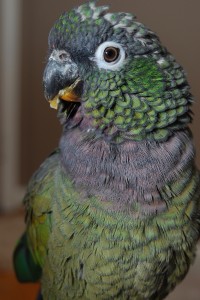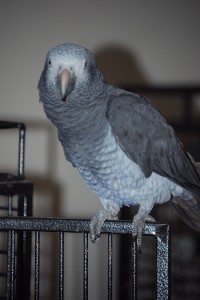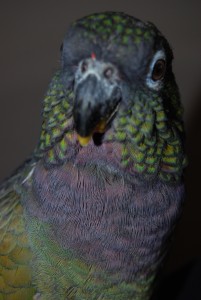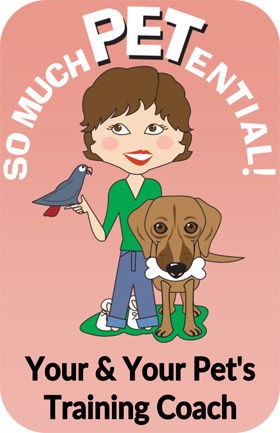parrot biting
Stopping Parrot Biting Without Force
NOTE: I have a new pet behavior blog. Please visit http://www.SoMuchPETential.com/blog. Thanks!
Dreyfuss is a bird who – if I’d let her – would spend her entire day sitting next to me or on me, frequently with her head down for rubs. So how was it that this sweet girl (who actually may be a boy but I’ve never had her sexed) would lung at my bare arm, and even bite it, when I’d put my arm in front of her body before asking for a ‘step up’ from her inside cage perch?
My education in behavior has taught me that biting doesn’t just ‘occur’ in a vacuum, and that before that aggressive behavior happens, a bird behaves with nonaggressive body language (such as dilated eyes, feathers fluffed) to let me know my arm is not wanted in its space. If I get bitten it is because I did not pull my arm away when the bird dilated its eyes or fluffed its feathers, causing the bird to need to escalate its behavior.
Yes, I know that. But I had been watching Dreyfuss’ body language and I just couldn’t see it. One second her body language was telling me she was eager to step up and the next split second she’d lunge.
My turning point came the moment I had written an email to a trainer I know. In it, I told her Dreyfuss’ behavior was ‘unpredictable’. I hit send and then had a WOAH moment. Hold on here, Lisa. You know better than that. And you have the skills to solve this without the use of force and set both you and Dreyfuss up for success.
Applied behavior analysis is a systematic approach to solving behavior problems by changing the environment in which the behavior occurs. It involves looking at the very specific behavior (such as a bird biting or screaming) and the related environmental context that signals and reinforces it. We ask, “What happened *immediately* prior to the behavior (antecedent) to set the whole ball rolling?“ And, “What happened *immediately* after the behavior to reinforce it (consequence)?“
There you have it…the A (antecedent), B (behavior), and C (consequence)’s.
So, let’s look at the ABC’s of this situation.
A(antecedent): Lisa puts hand on cage door
B (behavior): Dreyfuss either rocks from foot to foot or with slight movement
C (consequence): Lisa opens cage door
A: Lisa moves arm to Dreyfuss saying ‘step up’
B: Dreyfuss lunges or bites
C: Lisa removes hand
Prediction: Dreyfuss will lunge or bite more to get Lisa to remove her hand
I know, this doesn’t make sense for a bird that, once is on me, could live there. But obviously there is something about my arm being put in front of her that she didn’t want to have happen. How do I know? Because her behavior of biting/lunging continued and got more frequent.
The thing about studying behavior is that I don’t need to know what Dreyfuss was thinking. I only need to know that the behavior had a function for  her in her environment and I can then modify the environment to modify the behavior. I like to think about it as teaching new skills.
her in her environment and I can then modify the environment to modify the behavior. I like to think about it as teaching new skills.
So, what did I do? Well, I DID NOT use punishment or any kind of force.
What I did do is create a plan that would set us both up for success.
I taught her the contingency that *when* I put my hand on her door, *if* she moves to the left side of the perch, *then* I will put my arm in front of the right side of the perch. And *if* she walks over to and steps up onto my arm, *then* she comes out for attention, seeds, and more.
The power of deciding whether to come toward my arm to come out – or not – was ALL up to HER. And guess what, given the choice, she not only decided to come to my arm every single time – she runs to it and jumps on board.
How great is that!
So, here is the new ABC:
A: Lisa puts hand on door
B: Dreyfuss moves to other side of perch
C: Lisa puts hand at opposite side of perch
2nd ABC:
A: Lisa puts hand at opposite side of perch
B: Dreyfuss moves to hand and steps up
C: Lisa takes Dreyfuss out for attention, seed and more
Taking her out of her cage is that simple now. The beauty of it is that I never used force or punishment. My ‘unpredictable’ bird when it comes to getting her out of her cage, now reliably runs with her feathers relaxed to my arm and as a result we both have confidence in that situation.
To read my post on why parrots bite, please click this link.
My Thoughts On Taming A Pet Parrot
NOTE: I have a new pet behavior blog located at http://www.SoMuchPETential.com/blog. Thanks!
(one of my past Hyde Park Living columns)
Alright, I’ve got to speak my mind this month. I have heard so many people and seen so many web sites talking about ‘taming’ birds.
 Knowing what I know about behavior and being as compassionate as I am about other living beings, I hate that phrase. It makes me cringe actually because taming to me infers dominance and force. And dominance and force in no way helps build a relationship of trust and foster quality of life.
Knowing what I know about behavior and being as compassionate as I am about other living beings, I hate that phrase. It makes me cringe actually because taming to me infers dominance and force. And dominance and force in no way helps build a relationship of trust and foster quality of life.
Let me share some excerpts of ‘taming’ tactics suggested on web sites.
“If you make a fist and bend your wrist as far as it will go, you’ll notice that the skin on the back of the fist becomes very tight. Bring your fist up to the bird very slowly, finding out where its striking range is….The Fist, brought slowly toward the bird’s beak, can be used to control the bird, move it away from you, hold it off and let it know that you are not about to be driven out of the territory.”
“If your bird is so aggressive that you cannot safely place your hand inside its cage, try wearing thick oven mitts on your hands. If your bird bites the mitt, gently push in towards his beak rather than pulling away. This will eventually teach him that no matter how hard he bites you, he cannot make your hand disappear.”
“You have to expect the bites and be prepared to take them if need be..reacting to those bites is just about the worst thing you can do. Once the bird discovers that his bites WILL NOT back you down..he will stop trying.”
Let me repeat that with a BIG question mark. “Once the bird discovers that his bites WILL NOT back you down…he will stop trying.” REALLY? Some months back I devoted an entire column dispelling the reasons people use for why parrots bite. I’ve pulled a paragraph from it below.
Why then do birds bite humans? Well, for one humans who get bit generally aren’t very good listeners when it comes to watching their bird’s body language. They don’t allow their bird to nonagressively warn them to back off. Instead they push the limit and they have their body parts where they shouldn’t be (that’d be too close to a bird’s beak when the bird doesn’t want you there). They teach their birds that nonaggressive body language just doesn’t work in communicating to aggressive, grouchy or dominant humans.
I used to get bit, and bit hard, by Dreyfuss until I began studying behavior with Susan Friedman, Ph.D. about 10 years ago. Since then the only rare bites I have gotten have been when “I” have not paid attention to her body language.
My compassionate side shutters to think of that poor bird who has to come face to face with a person’s fist in order to learn how to be calm. In science, they call this ‘learned helplessness.’ It is when an animal is subjected to an aversive stimulus from which it cannot escape and it eventually stops trying because learns it is utterly helpless to change the situation. A great example of this is Jaycee Dugard, who stopped trying to escape her kidnapper, abuser and father to her children, after she realized it would do her no good to try.
Think about under what circumstances you are most eager to learn and you are most likely to succeed. Think about your favorite role model or teacher growing up or a favorite boss who inspires you to do your very best simply by believing in you and letting you learn from your own experiences.
That’s the type of person we need to be to our pets – a partner, friend and cheerleader, not a dictator and punisher. Instead of thinking about ‘taming’ your pet, think about setting your pet up for success. Your role should be to evoke joy in living, to make learning pure fun, and to make being with you the best choice ever because only good things come when you are around.















